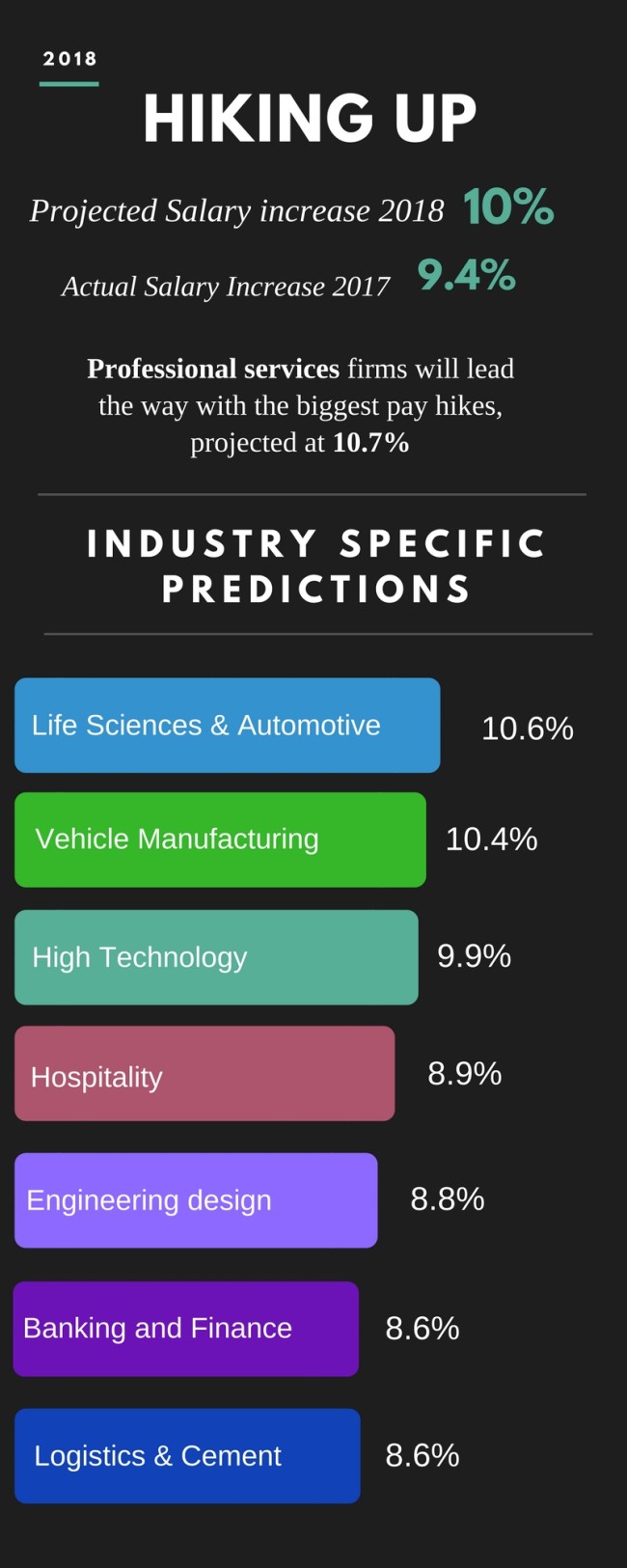Salary Trends 2018-Great Expectations

2017 saw a lot in terms of global political and economic volatility and the concomitant fluctuations in the job market. In India particularly, from demonetization, the institution of the GST regime to Trump’s mandates on the H1B visa program, the fluctuations (massive layoffs, contracting talent pools) in the business ecosystem mirrored the employee and employer sentiments alike.
Yet, the tumultuous 2017 still triggered excitement on many aspects and was a landmark year for many reasons especially for Indian employees and employers. From the passing of the Maternity Benefit (Amendment) Bill 2017, the extended maternity benefits, transformed business models to a robust adoption of disruptive technologies and automation, the year measured a stark and renewed interest of employers in rewards segment. The year also ended on a positive note as the hiring sentiment picked up during the last months of the year. The Manpower Group's India Economic Outlook estimated that there was a dip in the employers' hiring intentions in the first three quarters of 2017, before rising again in the October-December period. It also reflected on hiring that bounced back to 24 percent in October-December from a mere 16 percent in the period between July-September.

2018 seems to be the year of adjustments and uplifting of the lowered talent acquisition and management sentiments. Speculations reveal that recruitment landscape recovery is to continue from the end of 2017 to 2018, and organizations in the sectors of manufacturing, Fintech, and start-ups will execute robust hiring in 2018.
However, a significant boost in anticipated in the pay hikes. The projected pay hike for 2018 is being pegged at 10-15 percent across most sectors — a significant increase from 8-10 percent in 2017.While Mercer and WTW are in agreement on the projected salary increases, Aon Hewitt’s India Salary Increase Survey predicts that the upcoming appraisal season will see employees getting a projected average increment of 9.6 percent, up from 9.4 percent in 2017.The Aon survey also reveals that 71.9 percent companies reported salary increase budgets to be same as 2017 thus maintaining that the competitiveness of pay will continue to be a top reward challenge for firms.
Willis Towers Watson’s report states that although salaries in India are seeing a decreasing pattern in the year-on-year salary increases, India’s projected salary for 2018 is still the highest in the Asia Pacific region while salary projections for other countries is being pegged at — Indonesia at 8.5 percent, China at 7 percent; The Philippines at 6 percent, and Hong Kong and Singapore both at 4 percent. Echoing a similar sentiment, a latest Salary Trends Report1 by multi-national software and data firm ECA International (ECA), also reveals that Asia-Pacific countries dominate the top 10 spots in the global rankings with above-inflation salary increases. It ranks India in the second place globally behind Argentina with a projected 7.2 percent rise in real salary and reveals that India is expected to give workers a 4.9 percent real-pay increase in 2018.[1] In terms of increments, KPMG reveals that the average projected increment for the year 2017-18 was 9.7 percent, while the highest increment of 12.5 percent was reported by the e-commerce sector.
Mr. Nicolas Dumoulin, Managing Director, Michael Page India said, “Companies in India are more focused on recognizing the strong performers in their business. In an effort to retain them, firms are likely to reward them with better salary increases. As competition in the market gets stronger for top talent, professionals in specialist or business-critical roles will also see higher salary increases compared to 2017.”
While this highlights the overall predictions for salary trends, let’s take a closer look at the industry wise trends for 2018 and the projections as per few leading companies.
Industry-specific predictions
According to the report by Willis Towers Watson, Energy, FMCG, and retail sectors lead as the highest projected salary increase seen in these sectors is at 10.5 percent.And financial services sector is the only sector where the projected salary is at 9.1 percent, less than the overall estimated rise.
Aon Hewitt India Salary Increase Survey projects that professional services firms are leading the way with the biggest pay hikes, projected at 10.7 percent. Life sciences and automotive/vehicle manufacturing which have forecast hikes of 10.6 percent and 10.4 percent respectively, follow. Further, the high-technology sector is projecting an average hike of 9.9 percent in 2018. When compared to other sectors, the Banking and Finance sector is likely to have a lower projected pay hike, at 8.6 percent. The other sectors with lowest projected hikes in 2018 include hospitality/restaurants/travel at 8.9 percent, engineering design at 8.8 percent, cement at 8.6 percent and transportation/logistics/shipping service at 8.6 percent.
Ruchika Pal, Principal, India Practice Leader, Global Mobility, said, “Though cross-industry ranges have narrowed down to within a 1% point, we are witnessing more pronounced sub-segment differences within industries.”
While a decline in the salary increase for low performers is becoming a trend, the year-on-year salary increase for top performers continues to increase in line with the pay-for-performance agenda. Although projections and predictions provide an early insight to trends that will shape 2018 strategies, it is still a little early to get a clear picture as the upcoming budget will also influence the total reward strategies of companies.
Anandorup Ghose, Partner- Talent & Rewards Consulting, Aon Hewitt India also agrees to this sentiment. He said, “It is a little early to get a clear perspective on pay increases given the Q3 results are not out for companies and the budget scheduled for the 1st of February could really reshape the sentiments going forward.”
While he remains skeptical about the increments, he shares a takeaway for companies to remember while shaping their policies.
He said, “Companies will have to factor in rising inflation – there has almost been a 200 bps increase in inflation from the same time last year. At the same time, unless there is a significant change in business activity over the next few quarters, companies will find it very difficult to absorb compensation cost increases in the 10% and above range as India is used to seeing.”
Reference:-
[1] The Salary Trends for India, Us, UK, Europe, and Asia In 2018















